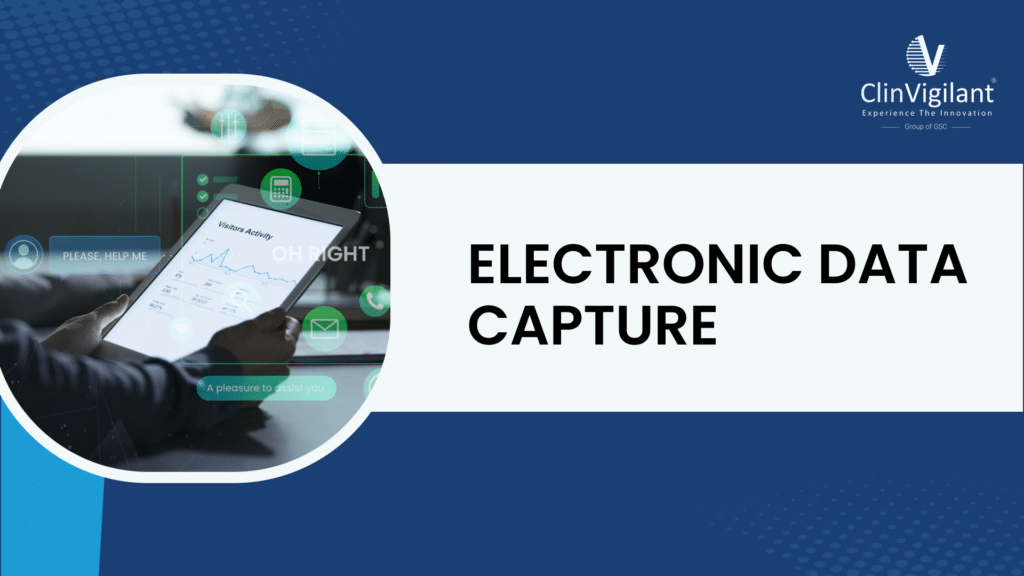Clinical trials are an essential part of developing new medications and treatments in healthcare. The accurate and efficient collection of participant data is critical to ensure the integrity of trial results. Historically, paper case report forms (CRFs) were used to collect data, which was then manually entered into databases for analysis. This process was time-consuming, expensive, and prone to errors. The emergence of electronic data capture (EDC) and electronic case report forms (eCRFs) has revolutionized clinical trials with powerful impacts on efficiency, accuracy, and cost-effectiveness.

Understanding Electronic Data Capture
Electronic data capture (EDC) Systems clinical trials refers to the process of collecting clinical trial data electronically instead of on paper. EDC systems provide electronic case report forms (eCRFs) and specialised software that integrates with the study database. Investigators and study coordinators can then directly enter participant data into standardised web-based forms from any location rather than filling out paper forms. The data is automatically uploaded to the main database for storage and analysis. This eliminates the need for manual data entry after paper CRFs have been collected.
EDC brings data accuracy and efficiency. It incorporates edit checks and validation rules to detect discrepancies during data entry. This minimises human errors compared to manual entry of paper records. EDC also enables automatic queries to be raised if data appears inconsistent or incomplete. The study team can immediately resolve discrepancies or missing data while the participant visit is ongoing. This “real-time” data cleaning prevents problematic data from accumulating towards the end of trials.
Overall EDC achieves faster database lock, allowing accelerated analysis and reporting. Costs are lowered by reducing on-site monitoring needed, paper shipping/storage, and manual data entry efforts. EDC empowers anytime, anywhere data entry to ease site workload. It facilitates remote, centralised monitoring for better consistency. Standardised eCRFs also support reuse in future trials.
The Power of EDC in Clinical Trials
There are significant advantages from EDC adoption that impact various aspects of trial conduct and success:
Improved Data Quality
EDC improves data quality through immediate validation checks at point of entry, reducing reliance on retrospective cleaning. Data quality metrics are also more readily assessed centrally in real-time. Errors from illegible paper forms or incorrect transcription are eliminated. EDC data has shown substantially lower error rates, consistently over 99% accuracy versus paper records. Complete and reliable data is invaluable in achieving trial integrity.
Accelerated Execution
As data cleaning occurs simultaneously during eCRF completion, clean data for analysis, review, and locking becomes rapidly available. Paper processes cause lags from data entry backlogs and mistakes, delaying database lock by months in some trials. EDC accelerates the availability of review-ready data, allowing analysis and reporting in days rather than months. Rapid results enable accelerated decisions on whether treatments show promise or need modification.
Enhanced Analytics
Digital data collection enables powerful analytics by combining data across all edc clinical study sites. Centralised data review provides consistent standards rather than relying on individual site monitoring. Built-in reporting makes insights on registration, recruitment and enrolment rates readily available to inform optimisation. Analytics on discrepancy rates also reflect data quality issues in real-time.
Increased Efficiency
Transitioning from paper to EDC markedly cuts resource needs for data management in trials. Printing, shipping, sorting and archiving boxes of paper CRFs disappears when documents are electronic. Most studies reduce monitoring visits by 50-70% as central review replaces site verification for quality control. Staff overtime for late night/weekend entry is slashed as forms are directly submitted online by sites. Such efficiencies translate to budget and personnel time savings.
Cost Savings
While implementing EDC software requires upfront investment, the downstream savings allow trials to realise a positive return on investment. A 2010 industry study found EDC reduced total data management costs by 23-46%, delivering average net savings of $250K per trial. Outsourcing data entry avoided -184K in costs per trial. Budget savings from efficiency gains can then be reallocated to expand trial scope, duration or sample sizes. The streamlining translates to quicker, cheaper and higher quality trials.
Challenges and Considerations in Implementing EDC
However, EDC also poses unique demands for planning:
Technological Investment
Selecting, validating and maintaining EDC systems requires expertise to evaluate capabilities, compliance and interfaces with other platforms used in trials. As trials frequently change protocols, flexible EDC systems that facilitate revisions save amendment costs. Personnel may also require training to optimise utilization.
Site Engagement
Sites provide critical “last mile” data directly impacting overall quality. Gaining user acceptance is key, as poorly designed or rigid systems risk frustrating site users. Intuitive, user-friendly interfaces tailored to workflows promote engagement for entering complete, accurate data. Supporting sites during onboarding onto new EDC platforms also eases adoption.
Data Security Considerations
Where sensitive personal data requires protection, EDC systems must provide state-of-the-art security with access controls, encryption and permissions restricting data visibility. Cloud hosting also raises unique data privacy considerations across systems and geographical areas involved. However, reputable EDC vendors provide the advanced cybersecurity to safeguard highly confidential trial information at rest, in transit and during processing.
Role of eCRF in EDC
A key component enabling EDC is the use of electronic case report forms (eCRFs) for data capture. eCRFs act as the portal for entry of participant data by replacing traditional paper forms with web-based online forms tailored to the study protocol. Their content directly mirrors paper CRFs but in digital formats for computerised handling rather than physical papers at each site.
eCRFs deliver powerful advantages:
- Uniform design ensures standardized data capture across global investigative sites for aggregated analysis
- Inbuilt validation rules facilitate real-time data checking during entry for quality and completeness
- Conditional logic skips to irrelevant fields conditional on values entered to prior questions
- Custom specification aligns to any study needs whether structured questionnaires or free text capture
- Revision logs retain amendment history throughout eCRF lifecycle
- Reuse as templates in future trials reduces costs of redevelopment
Together with a centralised database, eCRFs thus provide the foundation for smooth EDC adoption and its multitude of benefits in accelerating trial outcomes.
The Future of Electronic Data Capture in Clinical Trials and Research
Today EDC has been widely embraced as the new standard for data capture, now used in an estimated 68-73% of all trials compared to just 23% in 2006. The COVID pandemic further intensified demand driving EDC usage to nearly 80% of trials. Going forward, adoption will continue expanding into late phase and more complex trial designs as economics compel efficiency.
Exciting innovations on the horizon will also augment current EDC capabilities:
Integrating wearables, sensors and smartphone apps to automatically feed physiologic or patient-recorded data directly into EDC systems is a prime target currently in development. Machine learning integration will also enable “smart” CRFs to gain predictive abilities to flag discrepant values, suggest queries for verification or even autofill values from patient medical records. Cloud hosting services allow trials to benefit from the scale, security and cost efficiencies of shared cloud infrastructure. Blockchain implementations are also being explored to provide immutable audit trails securing entire datasets.
As Edc Clinical research grows more vast and intricate, EDC will evolve in lockstep to meet accelerating demands for better quality insights at lower costs. The coming decade heralds an exciting evolution for electronic data capture capabilities ushering ever more powerful impacts.
Conclusion
In summary, electronic data capture has delivered a revolutionary shift from paper processes to the new digital norm for collecting edc clinical trial data. EDC introduces enormous advantages in data quality, accelerated results and cost savings that touch all aspects of better, faster trials to advance healthcare insights for patient benefit. While introducing some unique demands around technology, site engagement and data protections, these considerations are far outweighed by the multifaceted benefits now achievable from EDC systems and eCRF adoption.
Powerful innovations on the horizon will only expand EDC capabilities to support more intricate research. The accelerating digitization of trials marks an exciting evolution in pushing the frontiers of biomedical knowledge through technology transformations.
FAQs
What are some key benefits of EDC adoption?
The advantages of EDC in clinical research include improved data quality from real-time validation checks; accelerated data availability speeding trial execution by months; enhanced central analytics from complete datasets; increased efficiency that cuts resource needs across trials; and cost savings from streamlined processes that pay back technology investments.
What is an eCRF and its role in EDC?
eCRF stands for electronic case report form. It is the online web portal that trial sites use to directly enter participant data that replaces traditional paper CRFs. eCRFs thus enable electronic data capture, acting as the gateway for digital collection powered by centralised databases and specialised EDC software. Their content mirrors paper CRFs converted to online formats.
What does the future look like for EDC innovations?
Ongoing EDC advances target integrating digital health technologies like wearables, sensors and apps to automatically feed data to platforms. Machine learning will enable “smart” eCRFs with predictive abilities. Cloud-based systems allow leveraging shared infrastructure for security, scalability and affordability. Blockchain implementations are also being built to deliver immutable audit trails securing complete datasets across systems.
Click here to know more about ClinVigilant’s EDC platform

